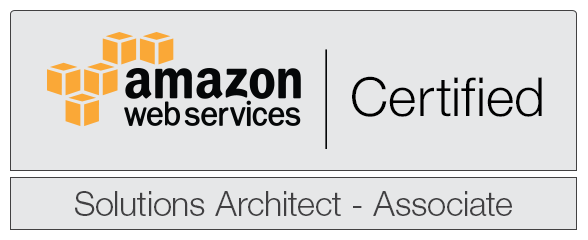The AWS Solutions Architect Associate is one of the three Associate levels in AWS certification. The other two being AWS Developer and AWS SysOps. In this post I’d like to give a simple overview of the process I underwent during my preparation for the Architect exam.
AWS Certified Solutions Architect – Associate
So what exactly is expected of an AWS Solutions Architect? We can break down his responsibilities in the following (taken from AWS):
- Designing and deploying scalable, highly available, and fault tolerant systems on AWS
- Lift and shift of an existing on-premises application to AWS
- Ingress and egress of data to and from AWS
- Selecting the appropriate AWS service based on data, compute, database, or security requirements
- Identifying appropriate use of AWS architectural best practices
- Estimating AWS costs and identifying cost control mechanisms
As you can see, a Solutions Architect has to have a broad view of different AWS services. He can then leverage that knowledge in designing and deploying highly scalable and fault-tolerant systems on the cloud. This also helps in reducing costs for the client.
Study Path Overview
I always look for different resources when studying or researching something. That way I can compile a list of information and create my study path based on the sources I have. This exam was no different. For a list of what I used:
- AWS Certified Solutions Architect Official Study Guide: Associate Exam
- AWS Certified Solutions Architect – Associate 2017 – (A Cloud Guru)
- Practicing on test dumps from Whizlabs
- Other additional information like AWS FAQ’s for different services and white papers
This is all I needed to pass the exam since before it I had no previous AWS experience. Some people might find a single resource like the book or just the video course sufficient. It all depends on their experience and study patterns. I didn’t have any previous AWS experience, so I was more comfortable with having a lot of information on my hands.
Plan and Execution
Now that we have a list of information we can start with the studying itself. The book is informative, although some of the chapters are very dry and a number of them don’t contain enough information on a subject. Overall I think it does the job in explaining the different services in Amazon’s cloud. The practical exercises at the end of every chapter are also good and at least for me were very valuable.
After I finished the book I got the A Cloud Guru video course through Udemy. While watching the videos I took a lot of notes which helped me cement the knowledge I’ve already gained from the book. The main difference here is that around 90% of the A Cloud Guru course is practical. You see and work inside the AWS Console most of the time. In a sense the book and the video course complement each other rather nicely! One is mostly theoretical while the video course is practical. The course also offers quizzes on the material which are close to the questions on the real exam. Overall the video course was money well spent!
Alongside the book, video course and a lot of note taking I also read FAQ’s for different AWS services and white papers. They’re mentioned in the book and course and are a valuable resource for an up to date information on a AWS Service. So I highly recommend reading some of them like:
- Overview of Amazon Web Services
- Well-Architected Framework
- Cloud Best Practices
- Overview of Security Processes
- Risk and Compliance
Last, but not least I practiced a lot with test dumps from Whizlabs. That put me into the mindset required for the exam and I learned a lot of new information while doing so. The majority of questions are based on real everyday situations and I learned some valuable lessons from that.
Pass
I passed the exam a couple of days ago! I hope the resources listed here can help you do the same when you try to tackle it!

